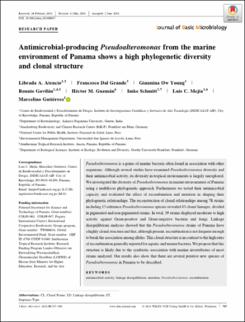Antimicrobial-producing Pseudoalteromonas from the marine environment of Panama shows a high phylogenetic diversity and clonal structure
Date
2018-06-02Author
Atencio, Librada A.
Dal Grande, Francesco
Ow Young, Giannina
Gavilán, Ronnie
Guzmán, Héctor M.
Schmitt, | Imke
Mejía, Luis C.
Gutiérrez, Marcelino
Metadata
Show full item recordAbstract
Pseudoalteromonas is a genus of marine bacteria often found in association with other organisms. Although several studies have examined Pseudoalteromonas diversity and their antimicrobial activity, its diversity in tropical environments is largely unexplored. We investigated the diversity of Pseudoalteromonasin marine environments of Panama using a multilocus phylogenetic approach. Furthermore we tested their antimicrobial capacity and evaluated the effect of recombination and mutation in shaping their phylogenetic relationships. The reconstruction of clonal relationships among 78 strains including 15 reference Pseudoalteromonas species revealed 43 clonal lineages, divided in pigmented and non-pigmented strains. In total, 39 strains displayed moderate to high activity against Gram-positive and Gram-negative bacteria and fungi. Linkage disequilibrium analyses showed that the Pseudoalteromonas strains of Panama have a highly clonal structure and that, although present, recombination is not frequent enough to break the association among alleles. This clonal structure is in contrast to the high rates of recombination generally reported for aquatic and marine bacteria.We propose that this structure is likely due to the symbiotic association with marine invertebrates of most strains analyzed. Our results also show that there are several putative new species of Pseudoalteromonas in Panama to be described.

